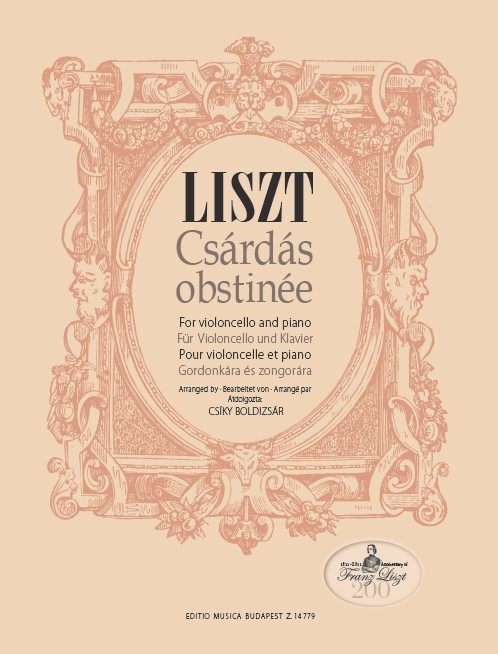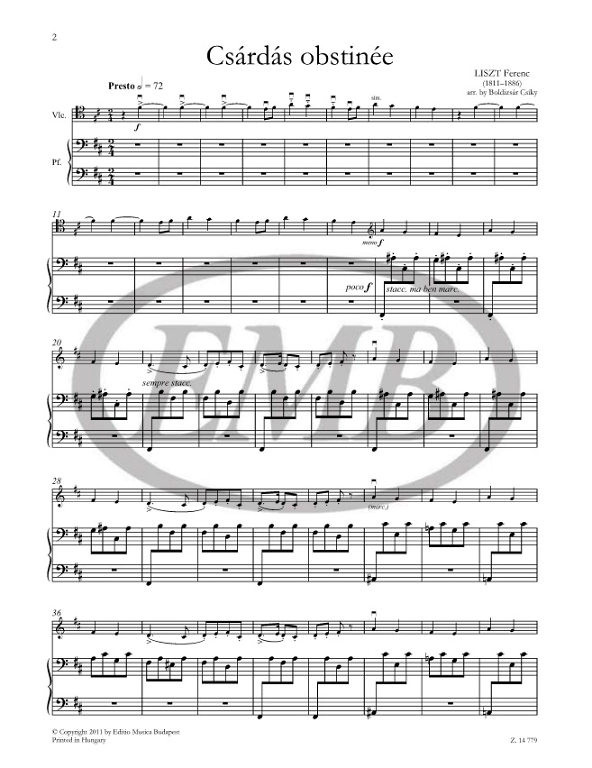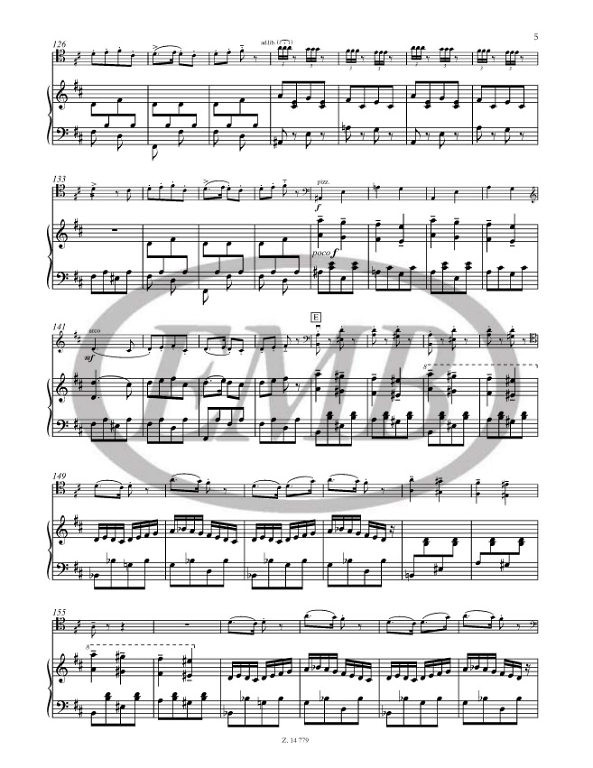Description
Liszt Ferenc: Csárdás obstinée / for violoncello and piano / Arranged by Csíky Boldizsár / Editio Musica Budapest Zeneműkiadó / 2011 / Átdolgozta Csíky Boldizsár
Paperback
Made in Hungary
Setting: Violoncello and Piano
Period: Romantic
Length: 16 pages
Format: Bach (23 x 30,2 cm)
Weight: 0.092 kg
Published: October 2011
Publisher: Editio Musica Budapest Zeneműkiadó
Item number: 14779
ISMN: 9790080147795 / 979-0080147795
Hangszer/letét: Gordonka és zongora
Korszak: Romantikus
Terjedelem: 16 oldal
Formátum: Bach (23 x 30,2 cm)
Súly: 0,092 kg
Első megjelenés: 2011. október
Kiadó: Editio Musica Budapest Zeneműkiadó
Katalógusszám: 14779
The arranger of this work (a well-known Hungarian composer living in Romania) writes: „This piece has always excited my imagination, from several points of view. First of all, its name. The German title, the obstinate one, may refer to its ostinato character. This is close to Liszt's programme concept, but the French word 'obstiné' is closer in meaning to stubborn. There is just a shade of difference, but to me it is important, because the latter suggests the description of a type of behaviour, the emotional state of a dancer's inner frame of mind abstracted into movements, expressed in dance movements, and this is a fascinating interpretation. The demonstration of stubborn resistance and defiance to the point of exhaustion was not a frequently occurring phenomenon with Liszt.
Secondly, at the beginning of the seventies Zoltán Kocsis played the piece in Transylvania. At that time, I asked the composer, ”Is the character of the continuous staccato in the left hand sharp, short, or an accompanying background like a constant shadow? Is it a weighty Brahmsian staccato, an ominous knocking? - and so on. Then there are the Bartókian false relations that keep recurring in the work, the B-E flat-G, etc. That foreshadows Debussy, creating harmonic thrills that, when I hear the work, keep my continuing interest alive for it. Finally, my immediate reason for arranging the work was of a family nature: in connection with Liszt's jubilee year, my daughter, who is a cellist, wanted a 'more energetic' piece to play at a bicentenary concert an addition to the existing slow, lyrical, or sombre works written by Liszt for the cello.”
A mű átdolgozója, a neves romániai magyar zeneszerző írja: "Ez a darab mindig is izgatta a fantáziámat, többféle szempontból is. Először is a neve. A német cím, a makacs, utalhat a benne levő ostinatív jellegre, ez közelít a liszti program-koncepcióhoz, de a francia 'obstiné' inkább a 'konok' szónkhoz áll közel. Ez árnyalati különbség, de nekem azért fontos, mert ez utóbbiból átsejlik egy magatartás ábrázolása, egy táncos belső lelkiállapotának táncmozdulatokban kifejezett, mozdulatokká absztrahált érzelmi állapota, és ez nagyon is megejtő magyarázat. A kimerülésig kitartó dac, a konok erő demonstrációja Lisztnél nem gyakori jelenség. A másik: a hetvenes évek elején játszta nálunk Kocsis Zoltán a darabot. Már akkor (és azóta) kérdem a szerzőtől: a balkézben végigvonuló staccato jellege éles, rövid, vagy állandó árnyékként kísértő háttér, avagy súlyos brahmsi staccato, netalán fenyegető kopogás - és így tovább. Aztán: a műben vissza-visszatérő bartóki keresztállások, a Debussyig átnyúló h-esz-g stb., olyan harmóniai izgalmat okoznak, amelyek a mű hallatán bennem állandó, nem múló érdeklődést tartanak fenn. Végül, az átírás közvetlen kiváltó oka családi hátterű: a Liszt-év kapcsán csellista lányom a rendelkezésünkre álló, Lisztnek gordonkára szánt lassú, lírai vagy komor hangvételű művei mellett egy 'energikusabb' darabot is szeretett volna játszani egy évfordulós koncerten...."


























